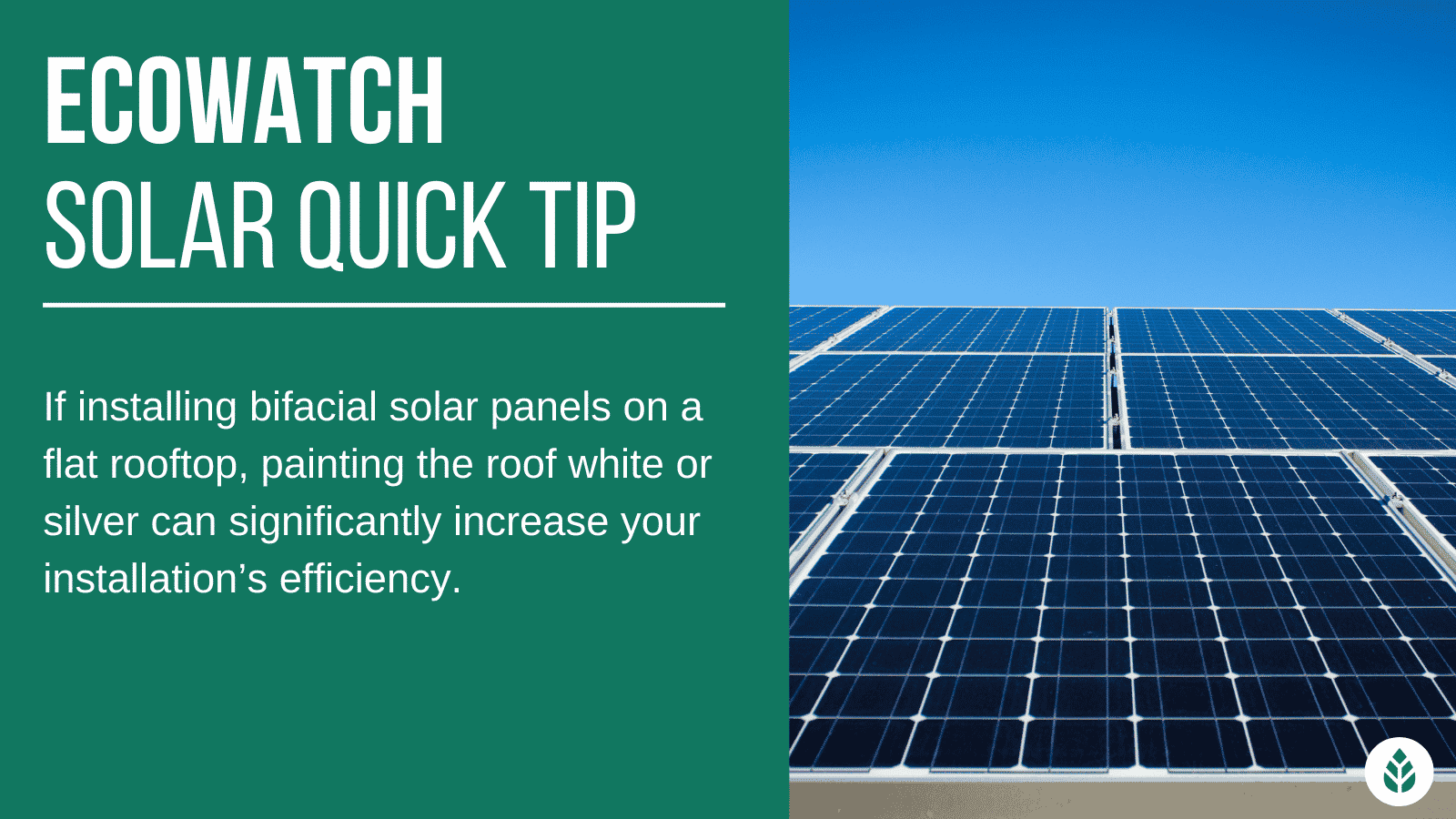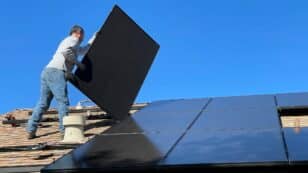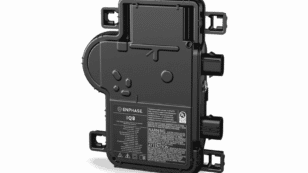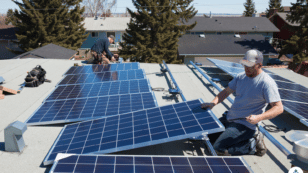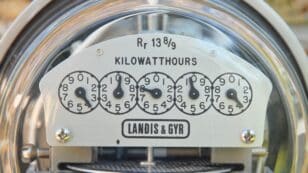
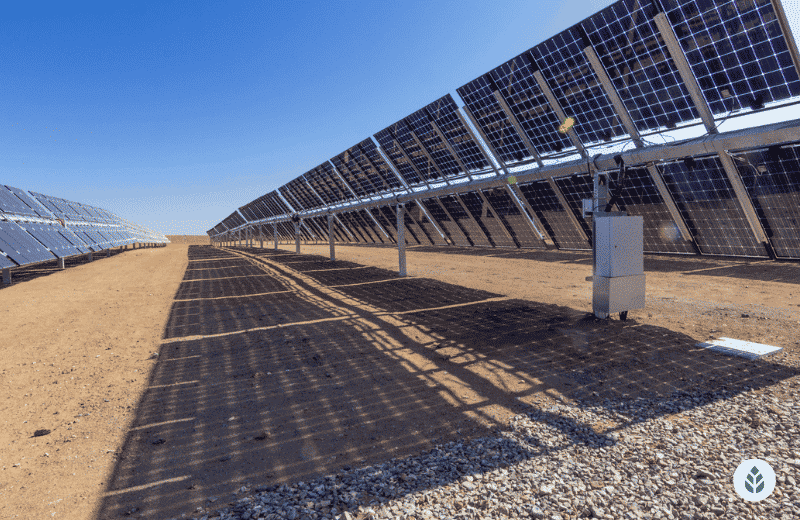
Bifacial Solar Panels Guide (Prices, Manufacturers & More) (2024)
Here’s what we’ll cover in this guide:
- What are bifacial solar modules?
- Bifacial vs monofacial solar panels
- Cost of bifacial solar panels
Each product and or company featured here has been independently selected by the writer. You can learn more about our review methodology here. If you make a purchase using the links included, we may earn commission.
What Are Bifacial Solar Panels?
A bifacial solar panel is designed with exposed solar cells on both sides of the panel. This allows sunlight to reach both the front and back of the solar cells for maximum solar energy harnessing.
This varies from traditional solar panels which are designed only to capture sunlight through their front side. In most cases, monofacial solar panels come with a frame and a backsheet made of polymers used to protect and isolate the electrical circuitry of the solar panel.
Bifacial solar panels unique transparent design of photovoltaic (PV) panels can also absorb reflected sunlight off of the ground, water or other materials. This makes bifacial solar modules an excellent choice for ground-mounted systems, carports and more.
What do Bifacial Solar Panels Look Like?
The panels are often frameless, with no metal gridlines impacting their structural integrity and aesthetic value. With this design, the solar panels have a noticeably thin profile and can be seamlessly added to canopies, carports, pergolas and sun-breakers.
Also, because they are designed to be raised from the ground on a racking system, there is less of a chance of the cells overheating.
Solar PV panels are made up of one of two types of crystalline cells: monocrystalline or polycrystalline. Most bifacial solar panels use monocrystalline cells, leading to maximum efficiency and therefore a higher price.

SunPower
Pros
- Most efficient panels on the market
- National coverage
- Cradle to Cradle sustainability certification
- Great warranty coverage
Cons
- Expensive
- Customer service varies by local dealer
SunPower designs and installs industry-leading residential solar and storage solutions across all 50 states. With a storied history of innovation dating back to 1985, no other company on this list can match SunPower’s experience and expertise.
SunPower earns its position as the top national installer on our list for a handful of reasons: It installs the most efficient solar technology on the residential market, offers the most expansive service area and backs its installations with a warranty well above the industry standard. All the while, SunPower pioneers sustainability efforts within the industry.
If that weren’t enough, SunPower systems come packaged with products all manufactured in-house by its sister company, Maxeon. This means that your panels, solar cells, inverters, battery and EV chargers are designed to work together and are all covered under the same warranty.
SunPower’s biggest downside? Its high-efficiency panels are considerably more expensive than most of its competitors’ products. However, its powerful panels are workhorses that make up for the initial cost with more backend production (think about this like spending more money for a car that gets more miles per gallon).
Facts and Figures: SunPower
| EcoWatch Rating |
|---|
| Better Business Bureau (BBB) Rating |
| Year Founded |
| Average Cost ($-$$$$$) |
| Solar Services |
| Brands of Solar Equipment Offered |
| Warranty Coverage |
| 5 |
| A+ |
| 1985 |
| $$$$ |
| Solar Panels, Solar Batteries, EV Chargers, System Monitoring |
| SunPower Panels |
| 25-year all-inclusive warranty |

Blue Raven Solar
Pros
- Industry-leading in-house financing
- Competitive pricing
- Excellent reputation
Cons
- Doesn't offer solar batteries (coming 2022)
We like Blue Raven Solar because it understands that, for most homeowners, the cost of solar presents the biggest barrier to entry.
For that reason, Blue Raven Solar developed an innovative solar financing plan that offers in-house, flexible, zero-money-down options. The results speak for themselves, as Blue Raven Solar is now one of the fastest-growing solar companies in the nation and was recently acquired by SunPower. Its BluePower Plus+ plan (exclusive to Blue Raven) mimics the flexible structure of a lease while still providing the greatest benefits of owning your system.
Eligible homeowners enjoy 18 months of solar power before having to pay their first bill. When coupled with the federal solar investment tax credit (ITC), the initial energy savings can offset more than a third of the overall cost of a system before requiring a dollar down.
In contrast, other installers can only offer similar financing through solar leases, PPAs or third-party providers (such as Mosaic or Sunlight). Third-party loan providers can complicate the process, while opting for a loan or PPA will disqualify you from some of solar’s biggest benefits (additional property value, federal solar tax credit and local solar incentives).
Facts and Figures: Blue Raven Solar
| EcoWatch Rating |
|---|
| Better Business Bureau (BBB) Rating |
| Year Founded |
| Average Cost ($-$$$$$) |
| Solar Services |
| Brands of Solar Equipment Offered |
| Warranty Coverage |
| 4.5 |
| A+ |
| 2014 |
| $$ |
| Solar Panels, System Monitoring |
| Trina Solar, Canadian Solar, SolarEdge, Silfab, SunPower |
| 25-year manufacturer warranty; 10-year workmanship warranty, 2-year production guarantee |
How Do Bifacial Solar Panels Work?
Bifacial solar panels work like a typical solar panel in the sense that sunlight is absorbed by the solar cells and then converted into energy. But unlike monofacial panels, bifacial panels have two translucent sides to absorb sunlight on both faces of the panel. This increases the total energy gained by the panel relative to the space it takes up.
If excess sunlight collides with a reflective surface below the panel, it can bounce back and be absorbed by the rear side of the solar module. With both sides of the solar panel generating power, bifacial solar energy can produce more solar energy than monofacial modules when the system is angled toward a highly reflective surface.
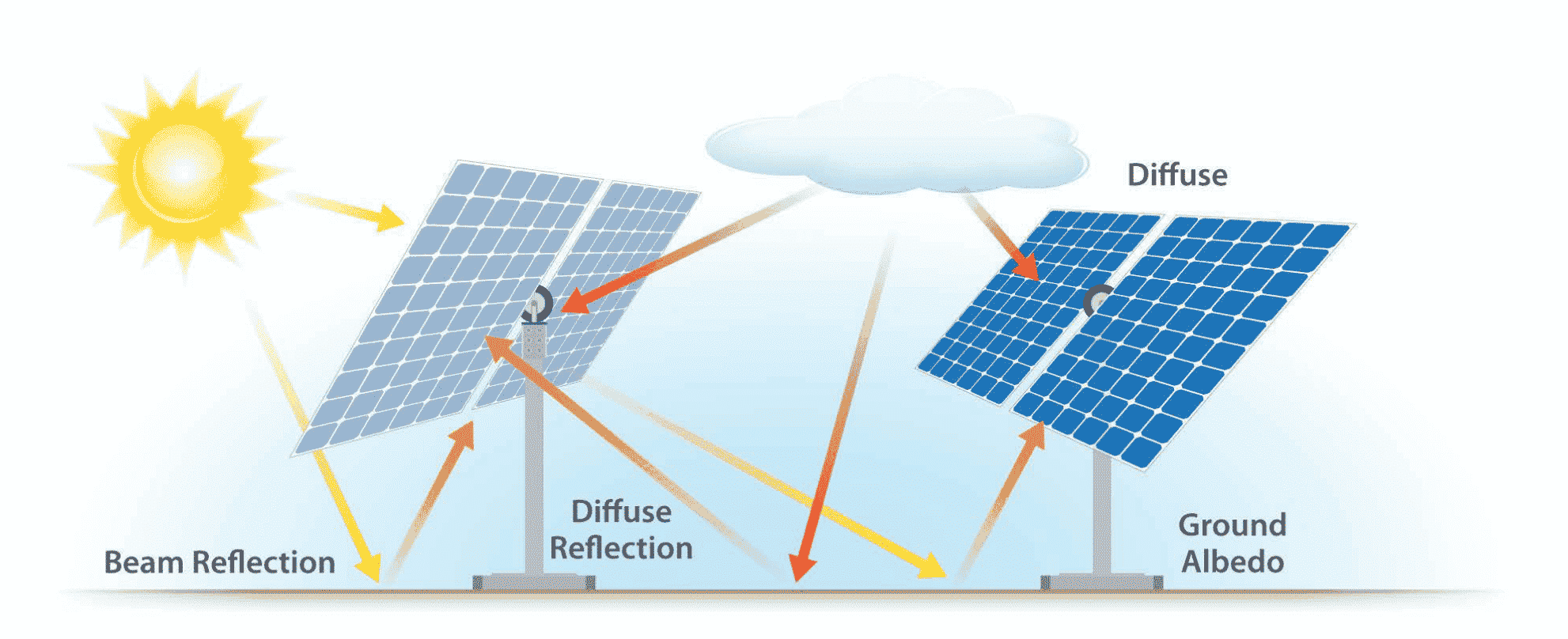
To utilize this technology, bifacial panels need to be installed with space behind them. This makes them impractical for most home solar panel installations where panels are installed directly on a rooftop.
The places where bifacial panels perform the best are near:
- Swimming pools
- Glass
- Sandy or stony areas
- Snow
Bifacial solar panels are even productive on cloudy days, as their design is centered around reflected light.
Bifacial vs. Monofacial Solar Panels
The main difference between a monofacial and bifacial solar panel is found in their design. Traditional monofacial panels have an opaque backsheet, but a bifacial solar panel is made with translucent faces, or dual panes of glass holding the cells in place.
The panels are designed to maximize energy generation by absorbing sunlight on the front and back. With this design, bifacial solar panels are more efficient than a typical solar array while requiring less space.
If a bifacial module is set up vertically, a homeowner can take advantage of peak sunlight hours at sunrise and sunset. With a vertical setup, solar panels also face far fewer impediments from weather, such as snow collecting on horizontal panels.
However, since the panel design is unique, the solar system will often require some extra work and equipment to continue functioning properly. Homeowners that choose bifacial solar cells will also have to invest in ground mounts and solar trackers to keep the panels aligned with the sun’s path.
When deciding whether a bifacial PV system is right for your needs, consider your latitude. Monofacial solar systems are the most cost-effective at latitudes below 40º because of the low reflected light, making bifacial solar systems more effective at latitudes above 40º. In fact, at latitudes beyond 65º, bifacial systems can achieve a 71% increase in energy production.
Bifacial PV technology has more advantages over traditional solar panels than just energy output. They are often more durable because both sides of the panels are UV resistant and because the module is typically frameless. This also decreases the chances of potential-induced degradation (which is essentially leakage of electricity due to a module consisting of varying materials).
Watch Below: See an up-close comparison of bifacial and monofacial solar panels.
How Much More Energy Can Bifacial Solar Panels Generate?
Since bifacial solar panels can absorb light from both the front and back, could they, in theory, double the efficiency of a solar system? Not quite.
A 2018 study by LONGi Solar showed that static bifacial solar panels can increase efficiency by 11% compared to a conventional solar panel system. When paired with a solar tracking system that tilts the cells toward the sun as it moves, efficiency could increase as high as 27%.
The exact amount of extra energy will depend on the environment surrounding the solar panels themselves, as well as the efficiency of your solar inverters.
How Are Bifacial Modules Installed?
Unlike monofacial solar modules, a bifacial solar module is not restricted to installations parallel to a surface, like a rooftop or ground mount. In general, however, bifacial installations are best suited for large-scale industrial, commercial or utility solar projects; they could also be an option for an off-grid solar system.
To maximize the amount of generated energy, bifacial panels should be installed in areas where light can reach both sides. This immediately disqualifies most residential rooftop installations.
When installing a bifacial module, capitalizing on Earth’s daily rotation is another way to harness the most amount of energy throughout the day.
The best way to do this is by choosing a ground mount or raised mount, but be sure to choose a system that is specially designed for bifacial and not monofacial panels. A monofacial system can have support rails covered by a backplate, which shades the bottom of the panel.
Where to Place Your Bifacial Solar Panel for Optimized Energy Capture?
There are four ways to make the most of a bifacial solar panels when it comes to how or where to install them:
- Install your panels tilted east to capture sunlight in the morning and also capture afternoon and sunset rays
- Install your panels vertically to capture two energy peaks a day
- Install your panels in a ground-mounted array with a solar tracking system to catch direct sunlight throughout the day
- Install your panels on a flat rooftop with a ground mount or a raised mount and a lot of room for tilting (best for multi-story apartments or buildings)
When considering a flat rooftop installation, painting the surface of the roof white or silver can yield higher efficiency. A white surface reflects more than 80% of albedo light. While upfront costs for roof painting might be daunting, improving reflection can prove financially beneficial.
Traditional solar mounts and racking are already designed for framed models, making a framed bifacial panel easier to install than a frameless one. However, most bifacial panel manufacturers include their own clamps for mounting. The clamps often come with rubber guards to protect the glass of the panels.
With regard to protecting the glass, installers must be careful to not over-tighten the bolts for risk of damage.
Bifacial Solar Panels for Residential Installations
Bifacial solar panels can be used for residential installations, but we recommend against them if you have a pitched roof also known as a gable roof.
While bifacial modules are great if you’re short on space, you shouldn’t install them flat against any surface, including the roof of your home. The solar module must be raised off of the roof or angled to catch reflected light on the back of the panel. For this reason, they perform best on large, flat commercial rooftops or ground-mounted arrays.
Bifacial panels are also more expensive than conventional panels. If you aren’t using them as intended, your residential setup will not produce the additional solar power needed to justify the cost. Traditional monocrystalline or polycrystalline panels can be purchased at a lower price and are the most cost-effective rooftop PV modules for homeowners.
While we don’t recommend bifacial panels for residential rooftop installations, there are still creative ways to utilize bifacial panels around a home. Some other ways to use the technology are installing the bifacial solar panels on the following:
- Pergolas
- Awnings
- Canopies
- Carports
- Other freestanding structures
Top 6 Bifacial Solar Panel Manufacturers
Since bifacial solar panel technology is so new, there are only a few manufacturers of the advanced technology — significantly fewer than traditional panel manufacturers.
There are several companies ready to fill the hole in the market, like SunPower, Jinko Solar, Hyundai Energy Solutions, Qcells and Canadian Solar. With its increasing popularity, more companies are expected to adopt the technology and join the marketplace.
Here’s what we like about the current manufacturers in the marketplace:
| Bifacial Solar Panel Manufacturer | What We Like: |
| SunPower | • Well-known in the solar industry • Efficiency ratings over 21% • Bifacial panels tolerant to shade • Highly durable |
| LG Solar Panels | • Some of the highest rated panels on the market • Efficiency ratings average around 19.5% |
| Jinko Solar | • Low cost • Efficiency ratings average around 20% |
| Hyundai Energy Solutions | • Large and reputable manufacturer • Many bifacial panels available • 19% efficiency on average |
| Qcells | • Utility-scale installers of bifacial panels • Excellent efficiency ratings around 21.4% on average |
| Canadian Solar | • Advanced bifacial cell technology • Utility-scale installer of bifacial panels • Highly durable |
While LG is included on this list, it recently announced it will be exiting the solar panel business to focus on other renewable energy solutions, such as solar storage. We decided to include them because, while panel production is currently winding down, LG has promised to support its U.S solar customers for years to come.
How Much Do Bifacial Solar Panels Cost?
Just like standard solar panels, the cost of bifacial solar panels has fallen dramatically over the last few decades. However, bifacial solar technology is still more expensive than a traditional solar array, a group of traditional solar panels.
Things like ground mounts for vertically mounted systems or solar tracking systems can drive up the bifacial solar panel price, adding 10 to 20 cents more per watt ($600 to $1,200 extra for a 6 kW solar system).
In larger utility-scale projects, bifacial panels can cost 1 to 5 cents more per watt. There’s good news if you’re looking to switch to solar for renewable energy in the next few years, however: A recent report by Wood Mackenzie Power & Renewables predicts bifacial panel costs may drop by 23% in the next five years.
Tariff Exemption on Bifacial Panels
In 2018, President Trump leveled tariffs on solar panels produced outside of the U.S. When the Biden administration took over, it maintained the tariffs, extending them for four more years in 2022. However, the administration chose to exempt bifacial solar panels.
The tariff was originally intended to create growth in the U.S. solar industry, but it limited access to less expensive options. Now, thanks to the exception, there is greater access to cheaper panels.
As of June 6, 2022, the Biden administration paused any new tariffs on solar panels to increase the adoption of clean energy nationwide.
Are Bifacial Solar Panels Worth It?
Yes, bifacial solar panels can be worth it — but it depends on your intended use. The technology doesn’t make sense for residential rooftop projects, but the increased efficiency makes them worth the higher upfront cost for commercial solar projects and utility solar developers.
Developers and manufacturers are still adjusting to managing the costs associated with bifacial modules, but costs will ease as the technology improves.
What Is the Outlook for Bifacial Modules?
Although the idea of bifacial solar panels has been around since the 1960s, breakthroughs in PV technology (such as with PERC solar cells) have only recently allowed bifacial solar panels to enter the market with viable levels of cost and efficiency.
Bifacial solar panels are already growing in popularity for large-scale applications, but they aren’t likely to have a massive impact on most residential consumers. Although the upfront costs are still on the higher end, the additional power garnered with a bifacial panel will justify the price with the right setup.
The best way to assess whether bifacial solar panels will suit your needs is by consulting a local solar installation company near you. Most will give free estimates along with their recommendations of the best solar panels for your home or business.
FAQ: Bifacial Solar Panels
Monofacial solar panels absorb sunlight through only one side of the panel. Bifacial is able to operate by absorbing through both sides of a panel. As such it is better to have bifacial panels installed vertically as a ground mount.
As mentioned above you can use bifacial solar panels on a roofs, specifically flat roofs work best. You can use bifacial solar panels on most roofs, but they end up being more efficient and creating more energy through a ground mount.
Related Solar Articles
- Which States Have the Best Solar Incentives
- What Is Net Energy Metering
- Solar Tax Exemptions: Sales Tax and Property Tax (2022)
- Biggest Advantages and Disadvantages of Installing Solar
- Solar Shingles Vs. Solar Panels in
- Best Direction for Solar Panels (Tips to Maximize Output)
- 3 Types of Solar Panels (Which Is Right for You)
Comparing authorized solar partners
-
- Most efficient panels on the market
- National coverage
- Cradle to Cradle sustainability certification
- Great warranty coverage
- Expensive
- Customer service varies by local dealer
A+Best National Provider1985SunPower Panels25-year all-inclusive warranty
Having trouble deciding? Click below and use our process to receive multiple quotes instead:

 233k
233k  41k
41k  Subscribe
Subscribe 


